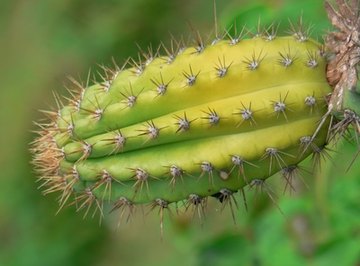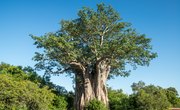
Deserts are considered to be the harshest terrestrial environment on the planet. Deserts are generally defined as arid areas that receive fewer than 250 millimeters (ten inches) of rainfall per year. This rainfall is often very erratic, from significant rainfall events that bring a whole year’s rainfall within several hours to dry periods that can span years without rainfall.
The temperature of the desert can range from up to 50 degrees Celsius (122 degrees Fahrenheit) during the day to below zero degrees Celsius (32 degrees Fahrenheit) at night, and the dry air results in high rates of evaporation. The soils are also generally sandy or rocky with little organic matter or available minerals. All these factors make deserts a challenging place to live for plants, animals and other organisms.
Despite this, deserts are home to a diverse range of species that have evolved specialized adaptations to cope with the climate extremes they experience. Due to their lack of mobility and dependence on rainwater for survival, many types of desert plants have a variety of adaptations to reduce water loss and survive in periods of drought. Plants that can exist in environments with very little water are called xerophytes.
Leaf Structures and Adaptations
Most plants lose the majority of their water through the stoma on their leaves. Stoma are openings in the leaf surface that allow a plant to exchange gases with the atmosphere. Many common desert shrubs and plants have characteristics that help reduce this water loss.
These adaptations include leaves with a small surface area-to-volume ratio, such as conifers and grasses. Some plants, such as cacti, have evolved to exist without true leaves, while others - including brittlebush and burroweed - lose their leaves and go into dormancy during dry periods.
Some plants, such as resurrection ferns and Rose of Jericho, will dry and desiccate to the point that they look dead. However, they can survive in this state for several years and spring back to life when exposed to water, becoming green and healthy again in just a few minutes or hours.
Some plants have a thick waxy layer, called a cuticle, that reduces evaporation. Others produce fine hairs or pale powders that achieve the same effect by reflecting the sun’s rays and cooling the plant.
Water Storage in Succulent Plants
Some dry-climate plants, such as cactus and agave, have adapted to take advantage of periodic rainfall by absorbing and storing excess water within their fleshy, or succulent, body tissue. To do this, they have developed extensive, shallow root systems that can rapidly absorb large amounts of water.
Many of these plants also use a specialized photosynthetic process that require less water than other plants. Called the crassulacean acid metabolism (CAM), this process allows plants to close their stoma during the day and open them at night, when evaporation rates are lower. This process allows them to produce more growth in dry environments.
Ephemeral Plants and Flowers
Many desert plants only emerge after periods of rain. These species, known as ephemerals, appear for only a brief period, between two to four weeks. In this time, seeds stored in the soil germinate, produce flowers and seeds, and then die, releasing the seeds to await the next rainfall events.
Seeds can survive for many years until conditions are suitable for germination. These flowering events can cause whole landscapes, normally arid and devoid of vegetation, to become carpeted in fields of colorful wildflowers.
Protection From Predation
As many desert plants grow slowly due to the limitations of water and nutrients, they are more susceptible to grazing and browsing than plants that grow in milder climates. Therefore, many have developed protective mechanisms against potential predators. Leaf adaptations to reduce water loss, such as a small surface area and waxy cuticles, also help to make the plants less palatable.
Many plants, such as cactus and acacia shrubs and trees, have spines and thorns that deter many browsing animals. Grasses such as Spinifex spp. contain tiny, sharp silica crystals along their margins that serve the same purpose. Plants can also produce poisonous or unpleasant-tasting chemicals.
References
- UC Museum of Paleontology: The Desert Biome
- BBC News: Chile's Atacama Desert: World's Driest Place in Bloom After Surprise Rain
- Arizona-Sonora Desert Museum: How Plants Cope With the Desert Climate
- The Conversation: It Is Risen: The Story of Resurrection Ferns and My Late Colleague Who Helped Discover Them in Australia
Resources
About the Author
Born and raised in Western Australia, I have been fascinated by the natural world for as long as I can remember. I studied Conservation Biology at Murdoch University before working as a government field researcher, project leader for community-led bushland regeneration programs, private botanical consultant and environmental educator. Although fascinated by all things ecological, a particular interest is regenerative agriculture and its potential to help transform our entire relationship with the natural world in which we depend.
Photo Credits
cactus 2 image by Marc Rigaud from Fotolia.com
